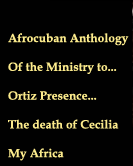




|
The
press and the Sorcerers of this century.
(it Belongs to the article the
girl's death Cecilia) The discovery in Matanzas of the small Cecilia Dalcourt's body, supposedly sacrificed by anthropophagous sorcerers, it untied the wave of racial tension of 1919 in Cuba that left the balance of seven deads and several wounded in Matanzas at the end of June. Soon after a black pedestrian was lynched in order (neighborhood of Havana) when only supposing exalted people that loaded a dead boy in her bag, to check after dead that the man didn't take anything incriminante in his bag. The paper of the written press was fundamental during the racial politics's development at the beginning of century, being reflected thoroughly from the covering of the girl's supposed ritual murder Zoila in Havana in 1904 (Ortiz, 1906) until arriving to the case of the girl Cecilia in Matanzas in 1919. The periodic Forecast was vital for the invigoration of the Independent Party of Color between 1907 and 1910, under Evaristo Estenoz's leadership, Pedro Ivonnet and journalist Gregorio Surín, claiming the racial integration of the nation with equality of opportunities for the Afro-Cuban population. The fights of the Independent ones against president's José Miguel Gómez government culminated in the armed protest of May 20 1912 that finished drowned in blood after the constitutional guarantees were suspended in East the 5 of Julio of that same year. In 1912 the most important newspapers in Cuba coincided in defining the protest lidered for the Independent of Color like a rebellion of the black ones against the white Cubans. The rebels insisted in that the protest was due to political reasons when being prohibited the participation of its party in the coming elections in November of that year. The presence of the feared sequel of the Haitian revolution was identified by the editorials while the topic of the white women violated by the black ones and the criminal bestiality of the sorcerers came out to glitter. The World and The Discussion affirmed that the black conspiracy in the Caribbean was directed from Haiti (Helg, 1995). The confrontation climate that prevailed from the racial war of 1912 was undoing the myths of racial equality in the Republic. The weekly publication The Brand published for Afro-Cuban in Havana printed a gratuitous supplement June 30 1919 condemning the lynchings in Matanzas and it Rules. The Club Atenas also disclosed a manifesto accusing to the press for the racist incitement of the public opinion in favor of the lynchings; Juan Gualberto Gómez and other veteran ones signed the document. The racial crisis during every year was focused on ethnocentric interpretations of the rites of the Rule of Palo Monte or Witch of the Afro-Cuban religiosity Rules. The suspicion of the criminal character that implies the practice of these traditions extended popularly in the public opinion to the practitioners of the Rule of Ocha well-known as santería as well as to you plant them Ñáñigos or society Abakuá and to the priesthood of Ifá. The Afro-Cuban intellectual vanguard didn't deny the supposed criminal nature of the ritual practices of African origin, but rather enarboló the ideology that not all the black ones are sorcerers neither practitioners of the ritual life or the wild culture of the drum." From the origins of the weekly publication The New Creole, published from 1904 by Rafael Saws, representative of the elect Moderate party for East, one pled for the education necessity and public employments for the black population criticizing to the Catholic Church for not accepting black in his private schools. It was criticized to the black families of low class to allow the employment of their children like domestic servitude, fomenting the spirit of servility in the Afro-Cuban youth; but there were not promotion neither true defense of the Afro-Cuban sociocultural values as component forgers of the Cuban nationality. |






